|
Militia /
American Revolutionary War Flags
|
Militia
/ American Revolutionary War Flags and Historical
Information
April
19, 1775 The government goes door to door
confiscating firearms. Gun fire results - soldiers
(i.e., government troops) vs. the militia (i.e.,
farmboys, drovers, carpenters, laborers, and school
teachers, etc...). The American Revolution is ignited!
Flags
Fly the Patriot Flags from the
American Revolution.
LINKS ON THIS
PAGE ARE STILL BEING UPDATED FROM MY PRIOR WEB SITE
|
|
MILITIA FLAG
|
DESCRIPTION
|
|
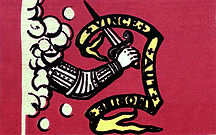
|
Bedford
Militia Flag
Bedford
Militia - Original Roster
Bedford
Militia - April 19, 1775
www.bedfordminutemancompany.org
The Latin
inscription "Vince Aut Morire" means
"Conquer or Die". The arm emerging from the
clouds represents the arm of God
|
|
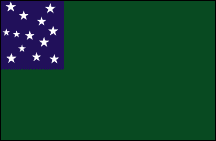
|
Green
Mountain Boys Flag
Green
Mountain Boys Militia
More
on the Green Mountain Boys Militia
|
|
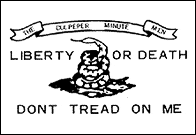
|
Culpeper
Minuteman Flag
Read
about the Culpeper Militia
|
|

|
Moultrie
Flag
The
Moultrie flag was
the first distinctive American flag displayed in the
South. It flew over the ramparts of the fort on
Sullivan's Island, which lies in the channel leading to
Charleston, South Carolina, when
the British fleet attacked
on June 28, 1776. The British ships bombarded the fort
for 10 hours. But the garrison, consisting of some 375
regulars -- and a few militia, under the command of Col.
William Moultrie, put up such a gallant defense that the
British were forced to withdraw under cover of darkness.
This victory saved the southern Colonies from invasion
for another two years.
The flag was blue, as were the
uniforms of the men of the garrison, and it bore a white
crescent in the upper corner next to the staff, like the
silver crescents the men wore on their caps, inscribed
with the words "Liberty or Death."
Source: http://www.foundingfathers.info/American-flag/Revolution.html
|
|
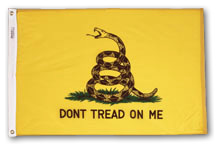
|
Gadsden Flag
The
Culpeper Flags
|
|
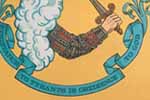
|
Revolutionary
Battle Flag
Like this one, many battle flags of the American
Revolution carried religious
inscriptions."Resistance to tyrants is obedience to
God"
Gostelowe
Standard No. 10, c. 1776
Watercolor once in possession of
Edward W. Richardson. Copyprint
Courtesy of the Pennsylvania Society of Sons of the
Revolution
and Its Color Guard (91)
|
|
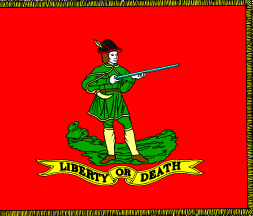
|
Hanover
Associators
They resolved:
'that in the event of Great Britain attempting to force
unjust laws upon us by strength of arms, our cause we
leave to Heaven and our rifles.'
Source:
"Flags to Color from the American Revolution."
This flag belongs to the Hanover Associators, and is on
page 17. The colors are listed as "Red field and
trim on cap; yellow fringe and scroll; black lettering
and cap; green ground and uniform with cream legs, trim,
feather and powder horn; brown belt and light blue rifle
barrel."
"The Hanover
Association of volunteers was formed on June 4, 1774,
in Lancaster County, Pennsylvania. They resolved 'that
in the event of Great Britain attempting to force
unjust laws upon us by strength of arms, our cause we
leave to Heaven and our rifles.' The rifleman on the
flag shows this point. This flag no longer exists, and
the authority for it is an ancient engraving in the
Pennsylvania State Archives." Randy Young,
1 February 2001
|
|
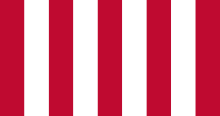
Sons of Liberty
|
|
|
Flags
of the
American
War for Independence
http://www.nwinfo.net/~jagriffin/revflag.htm
http://www.flagguys.com/hist.html
http://www.bwrcsar.us/flags.htm
|
|
|
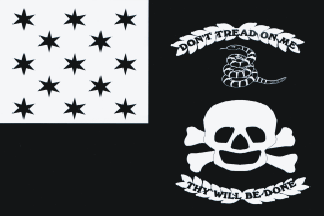
|
Veteran
Exempts Flag
By
Keith Herkalo
Both Roosevelt and Churchill recognized the strategic
and political importance of the land and naval battles
of Plattsburgh on September 11th, 1814. Yet time and
other events can obscure facts, and the United States'
second war for independence became a forgotten war, the
Battles at Plattsburgh lost in the "rockets red
glare" of Baltimore.
In this text, Keith Herkalo, using personal journals,
military journals, contemporary newspaper accounts, and
other original source documents, examines the evidence
that leads to the conclusion that the Battles at
Plattsburgh, on land and on Lake Champlain, were the key
battles of the War of 1812. The other battles,
Baltimore, Washington, and Sackets Harbor, were ruses
meant to divert United States troops away from the
prize: Plattsburgh, Lake Champlain, and a clear pathway
into New England.
If not for the explemlary talents and skills of two
young military officers, Commodore Thomas Macdonough and
General Alexander Macomb, a small force of regular army
and naval personnel and New York Militia, a few thousand
Vermont Militia, a handful of Native Americans and
Veteran Exempts (those too old for military service),
and a group of boys from the local school, the United
States, as we know it today, would not exist.
|
| Battle
of Bennington- 1777
Per
above link:
The
British suffered a major defeat when New England
militia men ambushed a large force of British soldiers
attempting to forage for supplies. The British force
was almost wiped out, losing 207 dead and 700
captured.
Burgoyne's
first major defeat occurred when he sent a force of
Hessians west of the Connecticut River to seize cattle
and other supplies. The force, commanded by Lieutenant
Colonel Fredrich Baum, was ordered to head to
Bennington and seize rebel supplies. Awaiting Baum
near Bennington were nearly 2,000 American militia men
led by John Stark of New Hampshire. At Van Schaick
Mill, Baum's forces ran into the advance guard of the
American forces, and both sides prepared for battle
the next day, next to the Wallomsac River. The British
were in makeshift fortifications on a height north of
the river. On August 16, after a rain delay, Stark's
men attacked. In a complicated multi-pronged attack,
they captured or killed the entire British force. By
late in the afternoon, a British relief expedition
arrived. The relief expedition was met by Warner's
Green Mountain Boys. They forced the British to pull
back. With the help of Stark's forces, the withdrawal
turned to a route. By the end of the battle, 207
British and Hessians lay dead and 700 were captured.
The Americans lost 20 dead and another 40 wounded.
|
| Battle
of Bennington
per above link:
The Battle of Bennington was
a battle of the American Revolutionary War, taking
place on August 16, 1777, not at its namesake of
Bennington, Vermont, but instead a few miles over the
border in Walloomsac, New York. An American force of
2,000 New Hampshire and Massachusetts militiamen, led
by General John Stark with aid from Colonel Seth
Warner, defeated a combined force of 1,250 Brunswick
mercenaries, Canadians, Loyalists, and Native
Americans led by Lieutenant Colonel Friedrich Baum.
British General John Burgoyne
was attempting to push through the northern Hudson
River Valley. After the recent British victories at
Hubbardton, Fort Ticonderoga, and St. Clair,
Burgoyne's plan was to defeat the American forces in
the area and then continue south to Albany and onto
the Hudson River Valley, dividing the American
colonies in half. The Battle was before Saratoga.
However, Burgoyne's progress
towards Albany had slowed to a crawl by late July, and
his army's supplies began to dwindle. Burgoyne sent a
detachment of about 800 troops under the command of
the Lieutenant Colonel Friedrich Baum from Fort
Miller. Half of Baum's detachment was made up of
Brunswick regulars, while the other half consisted of
local Loyalists, Canadians, and Native Americans. Baum
was ordered to raid the supply depot at Bennington,
which was guarded by fewer than 400 colonial militia.
On August 13, 1777, en route
to Bennington, Baum learned of the arrival in the area
of 1,500 New Hampshire militiamen under the command of
General John Stark. Baum ordered his forces to stop at
the Walloomsac River, about four miles (6 km) west of
Bennington. After sending a request for reinforcements
to Fort Miller, Baum took advantage of the terrain and
deployed his forces on the high ground. In the rain,
Baum's men dug in and hoped that the weather would
prevent the Americans from attacking before
reinforcements arrived. Deployed a few miles away,
Stark decided to reconnoiter Baum's positions and wait
until the weather cleared.
On the afternoon of August
16, 1777, the weather cleared, and Stark ordered his
men ready to attack. Stark is reputed to have rallied
his troops by saying, "There are your enemies,
the Red Coats and the Tories. They are ours, or this
night Molly Stark sleeps a widow." Upon hearing
that the militia had melted away into the woods, Baum
assumed that the Americans were retreating or
redeploying. However, Stark had recognized that Baum's
forces were spread thin and decided immediately to
envelop them from two sides while simultaneously
charging Baum's central redoubt head-on. Stark's plan
, the Loyalists and Native Americans fled. This left
Baum and his Hessian dragoons trapped on the high
ground without any horses. The Germans fought
valiantly even after running low on powder. The
dragoons led a sabre charge and tried to break through
the enveloping forces. However, after this final
charge failed and Baum was mortally wounded, the
Germans surrendered.
Shortly after this battle
ended, while the New Hampshire Militia was disarming
the German troops, Baum's reinforcements arrived. The
German reinforcements, under the command of Lieutenant
Colonel Heinrich von Breymann, saw the Americans in
disarray and pressed their attack immediately. After
hastily regrouping, Stark's forces tried to hold their
ground against the German onslaught. Before their
lines collapsed, a group of several hundred Vermont
militiamen arrived to reinforce Stark's troops. The
Green Mountain Boys, commanded by Seth Warner, had
just been defeated at the Battle of Hubbardton by
British reinforcements and were eager to exact their
revenge on the enemy. Together, the New Hampshire and
Vermont militias repulsed and finally routed von
Breymann's force.
Today the residents of
Bennington celebrate the battle, calling the day
Bennington Battle Day. That day the town fires
Americas oldest firing cannon, called the Molly Stark
Cannon.
Total British losses at
Bennington were recorded at 200 dead and 700 captured;
American losses included 40 Americans dead and 30
wounded. Stark's decision to intercept and destroy the
raiding party before they could reach Bennington was a
crucial factor in Burgoyne's eventual surrender,
because it deprived his army of supplies.
The American victory at
Bennington also galvanized the rebels and was a
catalyst for French involvement in the war.
August 16 is a legal holiday
in Vermont, known as Bennington Battle Day. The battle
is further commemorated by the 306-foot (93 m) tall
Bennington Battle Monument in Old Bennington.
|
| Battle
Of Bennington |
Sharpshooter’s
Pledge (a prior Veturing Crew I worked with years ago, and
I composed this for them):
On my honor, as a Lassen
Sharpshooter, Venturer / Scout, I promise:
To always follow the rules of safe
firearm handling and shooting;
To seek to master those physical
and mental factors essential to the firing of an accurate
shot;
To treasure my American heritage,
the Bill of Rights, and do all I can to protect and preserve
the Unalienable Individual Right to Keep and Bear Arms as
guaranteed by the Second Amendment;
To recognize such individual right
as being justly considered as the palladium of the liberties
of our republic and deterrent to, and defense against,
government tyranny and oppression.
Motto:
Exercising the American Bill of Rights.
|

















